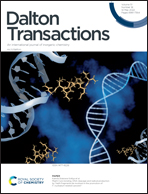Mononuclear Co(ii) polypyridyl complexes: synthesis, molecular structure, DNA binding/cleavage, radical scavenging, docking studies and anticancer activities†
Abstract
Mononuclear Co(II) complexes [CoII(L)Cl2]; 1, [CoII(L)(bpy)Cl]PF6; 2, [CoII(L)(phen)Cl]PF6; 3 and [CoII(L)(pic)Cl]; 4, (where L = N,N-bis(pyridin-2-ylmethyl)aniline, bpy = 2,2′-bipyridine, phen = 1,10-phenanthroline, pic = picolinic acid) were systematically synthesized and characterized by different analytical and spectroscopic methods. All the complexes were structurally identified by single-crystal X-ray diffraction analysis. Penta-coordinated complex 1 adopted a distorted trigonal bipyramidal geometry, whereas hexacoordinated complexes 2–4 have distorted octahedral geometry. The interactions of salmon sperm DNA (ss-DNA) with our synthesized complexes 1–4 were investigated by absorbance and fluorescence spectroscopy. All the complexes are very susceptible to DNA binding and exhibited binding affinities (Kb) in the order of ∼104 M−1, indicating their strong interaction with ss-DNA. The Stern–Volmer constant (Ksv) ranged from 0.46 ± 0.01 × 104 to 1.08 ± 0.04 × 104 M−1, suggesting weak or moderate binding with DNA. Agarose gel electrophoresis revealed the DNA cleavage activity in vitro for 2–4, which could efficiently cleave the supercoiled plasmid DNA without any external agents; however, with the addition of H2O2, the cleavage property was enhanced. Live-cell imaging and other biochemical assays demonstrated the ability of Co(II) complexes 1–4 to induce significant cytotoxicity in A549 lung cancer cells with IC50 values of 32.14 ± 1.3 μM, 3.14 ± 0.16 μM, 15.78 ± 0.72 μM and 18.45 ± 0.92 μM, and in MDA-MB-231 breast cancer cells with IC50 values of 20.42 ± 0.92 μM, 0.41 ± 0.02 μM, 2.31 ± 0.12 μM and 9.67 ± 0.35 μM, respectively.



 Please wait while we load your content...
Please wait while we load your content...